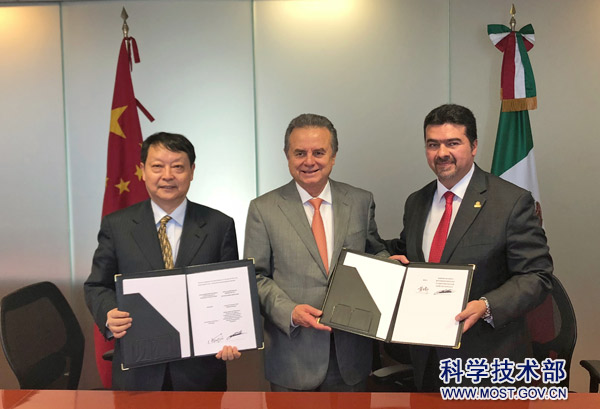
On May 18, 2018, the Science and Technology Subcommittee of China-Mexico Intergovernmental Standing Committee held its 7th meeting in Mexico City. The meeting was co-chaired by Huang Wei, Vice Minister of Science and Technology of China, and Enrique Cabrero Mendoza, Director General of Mexican National Council for Science and Technology (CONACYT) and attended by Guan Yapei, Political Counselor of the Chinese Embassy in Mexico, as well as relevant representatives of Chinese and Mexican government bodies and research institutes including the Ministry of Science and Technology of China (MOST), Chinese Academy of Sciences (CAS), National Natural Science Foundation of China (NSFC), Ministry of Foreign Affairs of Mexico, National Institute of Astrophysics, Optics and Electronics (INAOE), Center for Engineering and Industrial Development (CIDESI), Center for Research and Advanced Studies, and National Autonomous University of Mexico. The two sides exchanged views in an in-depth and full manner on the S&T developments of China and Mexico and reached consensus on a wide range of issues including the state quo of cooperation between Chinese and Mexican institutions and the promotion of bilateral STI cooperation.
Huang Wei, Vice Minister of Science and Technology of China, said that the Chinese government has always attached great importance to science, technology and innovation and has been committed to implementing the innovation-driven development strategy. At the 19th CPC National Congress held last year, it was expressly stated that innovation is the primary driving force behind development and the strategic underpinning for building a modernized economy. The report to the congress emphasized that China will continue to develop global partnerships and expand the convergence of interests with other countries. He added that under inter-governmental mechanisms such as the Joint Committee on Science and Technology Cooperation and the Science and Technology Sub-Committee of China-Mexico Inter-governmental Standing Committee, China and Mexico, with their strong complementarity, can carry out mutually beneficial science and technology cooperation with huge potential and bright outlook. Highlighting platform and mechanism building as an important part of bilateral science and technology cooperation, he expressed the hope that the two sides should promote all-round industry-academia-research collaboration in various ways including supporting joint research and strengthening exchange of research personnel to drive the economic and social development of the two countries. In addition, the Chinese Embassy in Mexico has always been active in advancing the China-Mexico ties in science and technology and will further leverage its role in facilitating bilateral science and technology cooperation.
Enrique Cabrero Mendoza, Director General of Mexican National Council for Science and Technology, said that since the establishment of diplomatic ties between Mexico and China in the 1970s, the bilateral relations have been continuously progressing, especially in recent years which have seen the two countries further enhance political mutual trust, with science and technology cooperation having become an important pillar of bilateral relations. Recognizing the huge potential of science and technology cooperation between Mexico and China, he hoped that the bilateral cooperation will further substantiate the comprehensive strategic partnership between the two countries. Mendoza spoke highly of China’s achievements in science, technology and innovation and said that Mexico is committed to further strengthening mutually beneficial cooperation with China in such areas as clean energy and biotechnology, increasing bilateral collaborative research and personnel exchange, and contributing to scientific and technological progress of the two countries.

During the visit to Mexico, Huang Wei met with Mexico’s Secretary of Energy Pedro Joaquín Coldwell and Deputy Secretary of Energy Leonardo Beltrán Rodríguez. The two sides exchanged views on strengthening bilateral clean energy cooperation and agreed to jointly support high-level collaborative research projects, which will help establish a stable relationship of bilateral industry-academia cooperation in clean energy, improve resource utilization efficiency, promote joint technological research and demonstration, promote the transfer of advanced and appropriate technology, and facilitate personnel exchange and technical training. The two sides will prioritize joint research projects on small hydro for support and will release the guidelines for call for projects as soon as possible.
After the meeting, Huang Wei and Leonardo Beltrán Rodríguez signed the Memorandum of Understanding for Energy Cooperation between the Ministry of Science and Technology of the People’s Republic of China and the Secretariat of Energy of the United Mexican States.

